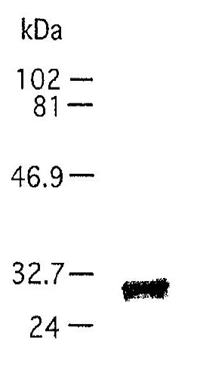IM32
Anti-TIMP-1 (Ab-1) Mouse mAb (7-6C1)
liquid, clone 7-6C1, Calbiochem®
Sign Into View Organizational & Contract Pricing
Select a Size
Select a Size
Change View
About This Item
UNSPSC Code:
12352203
NACRES:
NA.41
biological source
mouse
Quality Level
antibody form
purified antibody
antibody product type
primary antibodies
clone
7-6C1, monoclonal
form
liquid
contains
≤0.1% sodium azide as preservative
species reactivity
rat, bovine, human
should not react with
mouse
manufacturer/tradename
Calbiochem®
General description
Matrix metalloproteinases (MMPs) are a family of enzymes that are responsible for the degradation of extracellular matrix components such as collagen, laminin and proteoglycans. In addition to sequence homology, all MMPs share the following characteristics: the catalytic mechanism is dependent upon a zinc ion at the active center, they cleave one or more extracellular matrix components, they are secreted as zymogens which are activated by removal of an approximately 10 kDa segment from the N-terminus and their activity is regulated by endogenous inhibitors. These enzymes are involved in normal physiological processes such as embryogenesis and tissue remodeling and may play an important role in arthritis, periodontitis, and metastasis.The activation and activity of MMPs are regulated by a family of endogenous inhibitors, tissue inhibitors of metalloproteinase (TIMP). TIMP-1 (also called EPA, Fibroblast collagenase inhibitor or collagenase inhibitor) is a 28 kDa glycoprotein that is expressed by a variety of cell types. It forms a non-covalent, stoichiometric complex with both latent and active MMPs. TIMP-1 preferentially binds and inhibits MMP-9. TIMPs are capable of altering the metastatic potential of cancer cells and have been shown to inhibit invasion and metastasis in animal models.
Purified mouse monoclonal antibody (see application references). Recognizes the ~28 kDa TIMP-1 protein.
Recognizes the ~28.5 kDa TIMP-1 protein. Also recognizes MMP/TIMP-1 complexes.
This Anti-TIMP-1 (Ab-1) Mouse mAb (7-6C1) is validated for use in Immunoblotting, Immunocytochemistry, Paraffin Sections for the detection of TIMP-1 (Ab-1).
Immunogen
Bovine
purified, bovine dental pulp TIMP-1
Application

Immunoblotting (1 g/ml, see application references)
Immunocytochemistry (see application references)
Paraffin Sections (25 g/ml, see application references, see comments)
Packaging
Please refer to vial label for lot-specific concentration.
Warning
Toxicity: Standard Handling (A)
Physical form
In 100 mM sodium phosphate buffer, 0.1% BSA, pH 7.0.
Reconstitution
Following initial thaw, aliquot and freeze (-20°C).
Analysis Note
Positive Control
rTIMP-1 Protein (Cat. Nos. PF019 or PF020)
rTIMP-1 Protein (Cat. Nos. PF019 or PF020)
Other Notes
Also recognizes TIMP-1/MMP complexes.This antibody has been used to stain paraffin sections fixed with PLP (perioddate-lysine-4% paraformaldehyde) and 10% formaldehyde (using 25 µg/ml antibody). Antibody should be titrated for optimal results in individual systems.
Fujimoto, N. and Iwata, K., 1994. Connective Tissue26, 237.
Cottam, D. W. and Rees, R. C., 1993. Intl. J. Oncol.2, 861.
Stetler-Stevenson, W. G., et al. 1993. FASEB J.7, 1434.
Woessner, J. F., 1991. FASEB J.5, 2145.
Liotta, L. A. and Stetler-Stevenson, W. G. 1990. in Seminars in Cancer Biology ed. M. M. Gottesman. Vol. 99-106.
Cottam, D. W. and Rees, R. C., 1993. Intl. J. Oncol.2, 861.
Stetler-Stevenson, W. G., et al. 1993. FASEB J.7, 1434.
Woessner, J. F., 1991. FASEB J.5, 2145.
Liotta, L. A. and Stetler-Stevenson, W. G. 1990. in Seminars in Cancer Biology ed. M. M. Gottesman. Vol. 99-106.
Legal Information
Manufactured by Daiichi Fine Chemical Co., Ltd. Not available for sale in Japan.
CALBIOCHEM is a registered trademark of Merck KGaA, Darmstadt, Germany
Not finding the right product?
Try our Product Selector Tool.
Storage Class Code
12 - Non Combustible Liquids
WGK
WGK 2
Flash Point(F)
does not flash
Flash Point(C)
does not flash
Certificates of Analysis (COA)
Search for Certificates of Analysis (COA) by entering the products Lot/Batch Number. Lot and Batch Numbers can be found on a product’s label following the words ‘Lot’ or ‘Batch’.
Already Own This Product?
Find documentation for the products that you have recently purchased in the Document Library.
Our team of scientists has experience in all areas of research including Life Science, Material Science, Chemical Synthesis, Chromatography, Analytical and many others.
Contact Technical Service